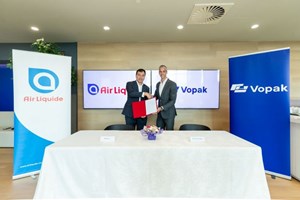News
Air Liquide and Vopak sign MoU to collaborate on H2 distribution infrastructure
Air Liquide and Vopak have signed a Memorandum of Understanding (MoU) to collaborate on the development and operation of infrastructure for ammonia import, cracking and H2 distribution in Singapore.
Ammonia is considered as one of the low-carbon fuels for power generation and the maritime industry. As a H2 carrier, it is one of the most efficient ways to store and transport H2. Leveraging on an established global supply chain and infrastructure for ammonia production, transportation and utilization, once transported, ammonia can be converted into H2 to contribute to the decarbonization of industry and mobility.
As such, the parties will study and explore the joint development of low-carbon ammonia supply chains in Singapore, including the potential development of ammonia cracking facilities, associated ammonia storage and handling infrastructure at Vopak’s Banyan terminal, and the distribution of low-carbon H2 through a H2 pipeline network. This collaboration aims to support Singapore’s National H2 Strategy, focusing at driving advanced H2 technologies with high commercial readiness to establish low-carbon H2 supply chains.
Zhang Xi, Southeast Asia Cluster Vice President, and Managing Director of Air Liquide Singapore said, “Air Liquide is committed to partnering with industry partners, such as Vopak, to offer innovative and sustainable solutions in support of Singapore’s decarbonization efforts. Air Liquide’s industrial scale ammonia cracking pilot plant is under construction in Belgium. We are proud to apply our expertise to crack low carbon ammonia into low-carbon H2, aimed at reducing carbon emissions in industrial basins and hard to abate sectors, advancing towards a more sustainable future.”
Rob Boudestijn, President of Vopak Singapore said, “H2 and ammonia have the potential to significantly contribute to Singapore's transition towards a low-carbon economy. As Singapore gears up for receiving and handling ammonia for power generation and bunkering, cracking of ammonia into H2 presents an additional application to help the industry shift to lower carbon feedstock. We are excited about collaborating with Air Liquide to accelerate the adoption and commercialization of industrial ammonia cracking in Singapore.”


